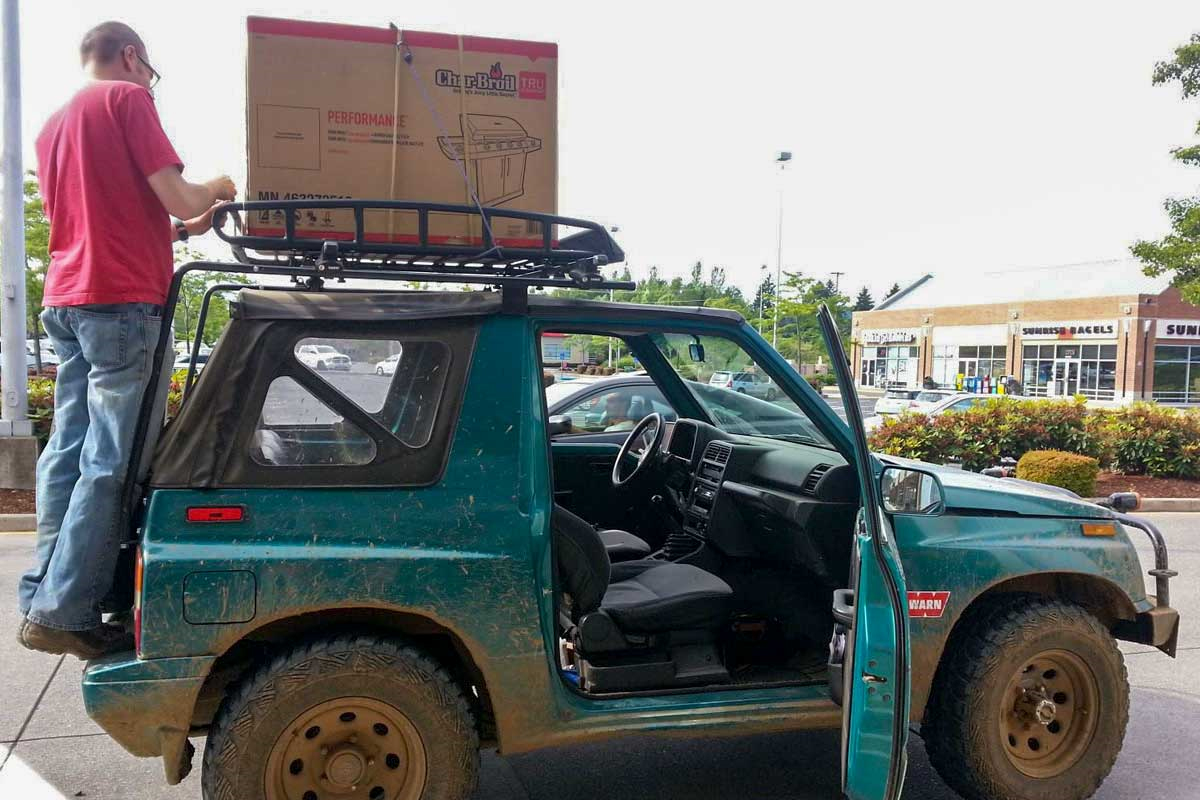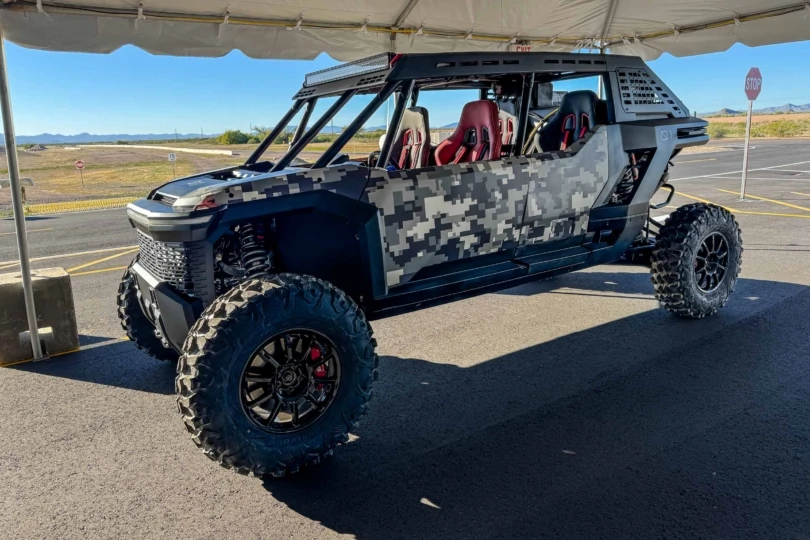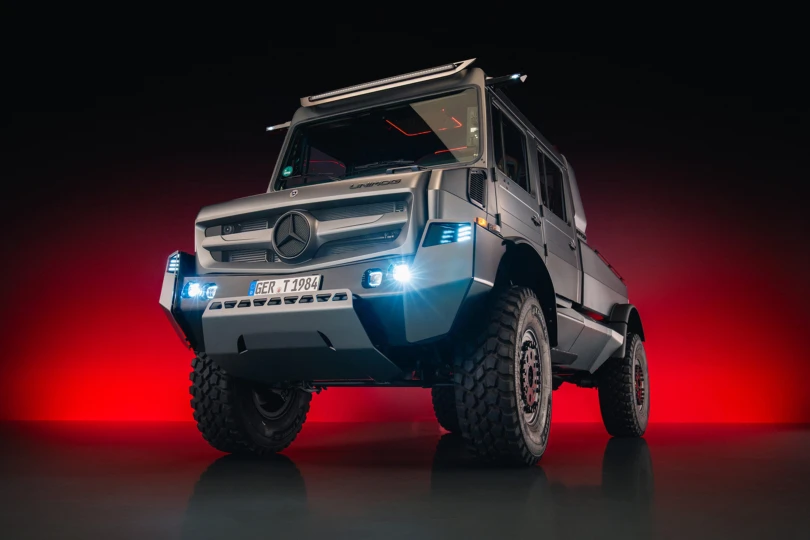Sometimes you run out of room inside your car, truck, or SUV when you’ve got lots of gear to carry. When this happens, using a rooftop cargo carrier can be a great way to add extra storage.
There are a host of ways to carry whatever it is you need. Of course, you have your specific carriers — bike, kayak, and ski/snowboard racks — but for those looking to carry other gear, your options basically boil down to three choices: roof baskets, roof boxes, or roof platforms.
Each cargo-carrying method has pros and cons, and we’ll look at the good and not-so-good things about each one.
Roof Basket: Wide Availability, Good Versatility; Doesn’t Keep Gear Dry

The roof basket is the most ubiquitous rooftop cargo-carrying contraption. You see them on pretty much all vehicles, and they’re available at nearly every sporting goods shop, auto parts store, and vehicle outfitter.
They also come in many shapes, sizes, and configurations, and easily attach to a roof rack’s crossbars — whether those are factory-installed or aftermarket versions.
Typically made from steel or aluminum bars welded or bolted together, baskets have raised sides to keep cargo in a confined area. That multi-bar construction means they’re great for use with ratchet straps, bungee cords, cargo nets, or a combination of the three, as those bars are natural tiedown points.
Baskets can haul a variety of gear from firewood or wet diving gear to extra luggage or auxiliary fuel. You can stack lots of stuff up there, but remember to get straps of some sort to secure your cargo, as the sides alone aren’t going to cut it.
Sometimes, their open-to-the-elements nature is a good thing. For example, when carrying wet gear you don’t want inside the vehicle — it might even dry up there! Just remember, everything up there needs to be secured.

Baskets are the most straightforward in terms of features, although prices range wildly. Tip: You get what you pay for. Low-dollar units are made from thinner material, have low-grade paint or powder coating prone to rusting, and aren’t as sturdy. Stepping up to mainstream brands, such as Thule, Yakima, or Rhino-Rack, will definitely be a step up in quality and durability.
Higher-end baskets are also available from more overland-centric outfitters such as ARB or BajaRack. Often these baskets offer accessories such as sturdy tiedown points, fuel can holders, spare tire holders, or shovel accessories, letting users tailor their basket to their individual needs.
Roof rack systems will put a dent in your vehicle’s fuel economy due to aerodynamics. However, some baskets offer a fairing to help with aerodynamics and noise reduction at speed. Of the three cargo-carrying methods featured here, baskets can make the most wind noise due to high profiles.

What roof baskets aren’t good for is keeping things protected from the elements. To keep firewood dry, we suggest throwing it in the vehicle if it’s raining. If you’re carrying luggage, make sure it’s not going to rain or snow.
Also, their raised rails limit the size and shape of cargo you can carry in the basket. For example, skis or snowboards aren’t always a good idea for a roof basket.
So, what if you want extra space and want to keep your cargo dry? For that, you’ll want a roof-mounted cargo box.
Cargo Box: Protection From the Elements and Prying Eyes, Potentially Pricey

Like the roof basket, the cargo box offers a great way to carry a variety of things, but you can also keep the gear you’re carrying out of the elements and out of the eyes of onlookers. Many times, these boxes are aerodynamic to keep fuel economy up and wind noise down. Some of the sleek, low versions aren’t good for carrying much other than skis, but others can be excellent at covered cargo carrying.
If you’re looking to haul stuff on your roof and want to keep it dry, the cargo box is the way to go. However, not all boxes are watertight. Some offer better sealing than others and can come complete with gaskets to keep water, snow, and dust out. Just be sure to look at each box’s features before buying.
There are more components to a cargo box versus a roof basket. This includes hinges, latches, locks, straps, and even struts that help hold the top open. Some lock. Others open from the sides. Some have carpet and even solar! The more features, the more money you should plan to spend.
Materials and construction will vary widely, and most cargo boxes are priced according to the features they have. Inexpensive boxes offer cheap and flimsy attachment methods to affix to your vehicle’s crossbars. Other companies offer clamps that look like a bird’s claw that adjust around the bar. Some use very strong U-bolts.
Entry-level boxes are constructed out of thin plastic and often feel cheap. Prices generally start around $300. Stepping up to midgrade boxes will give you better components and attachment methods.

High-end boxes, such as the Oregon-made Packasport Day Tripper that sits atop our JDM 1992 Mitsubishi Pajero, are made from fiberglass and can even be coated with a durable Raptor Tough finish. Weatherproof carpet lines the interior.
It features gas-charged struts to keep the top open and has high-quality latches and lock components, making it the next thing to heirloom material. More expensive boxes typically are in the $1,000-3,500 range, depending on size, features, and construction.
Cargo boxes also come in an endless variety of shapes. There are ultra-sleek (ultra-expensive) models that look like they’ve been wind-tunnel tested. There are short, tall, and often inexpensive units that may eat up extra fuel economy but can store bulkier items. Since most carriers are somewhat aerodynamic, they’re the best for retaining fuel economy.
Despite their ability to keep goods dry and secure, sleek cargo boxes aren’t always durable enough for those looking to venture off-road. The off-road crowd often prefers the basket or our next option — specifically, the platform rack.
Platform Racks: Blank Canvases; Harder to Fit, and Some Accessories Required

While roof baskets have raised sides, platform racks do not (and are sometimes called flat racks). They have a low profile and are made from durable steel or lightweight aluminum and are composed of welded bars, or slats and rails. They’re also the most modular and allow for different attachment methods.
Plus they offer tons of accessories such as brackets for awnings, showers, shovels, storage boxes, tiedowns, and more. For this reason, they’re most popular with the overlanding/adventure travel crowd. You’ll see them mostly on 4WD SUVs, vans, and even some pickups.
Most platform racks also differ from roof basket and cargo boxes in the way they attach to the vehicle. Most do not utilize crossbars; instead, they attach to a vehicle’s rain gutters or factory side rails.
Often, they’re vehicle-specific, or require custom fitment to be installed correctly — that’s one reason you don’t see them as often as roof baskets or boxes. They are, however, often the most durable in off-road situations.

While you can frequently pick up roof baskets at bargain-basement prices (and at bargain-basement quality), the platform rack segment is typically more expensive but made better. Some of the better-known brands of platform racks include ARB, BajaRack, Front Runner Outfitters, Prinzu, and Rhino-Rack, among others. However, with their growing popularity, mainstream rack makers, such as Yakima are getting into the fray.
Many times, the accessories are proprietary for these racks. So don’t expect the BajaRack tire mount to attach to the Front Runner Slimline rack, for instance. You’ll have to invest in that brand’s system if you want all the goodies. And as a rule, you’ll need accessories (at least eyelet tiedown points) to carry pretty much anything.
Which Roof Top Cargo Carrier Is Right for You?
Roof baskets are easy to find and easy to mount, but they won’t keep gear dry. Roof boxes are aerodynamic, quiet, and secure, but can be expensive and perhaps not as accommodating for cargo.
Flat racks offer a blank canvas for cargo carrying, but usually require accessories to get the most out of them. Plus, they’re the hardest to fit on vehicles.
Ultimately, the choice is up to you and should be based on your gear-hauling needs. However, no matter which you employ, ensure that you properly secure the cargo and that your roof attachment method is up to the task of whatever you’re carrying.
Additionally, understanding the rack system’s weight capacity as well as weight rating limits of your vehicle can help ensure years of future cargo-carrying possibilities.









